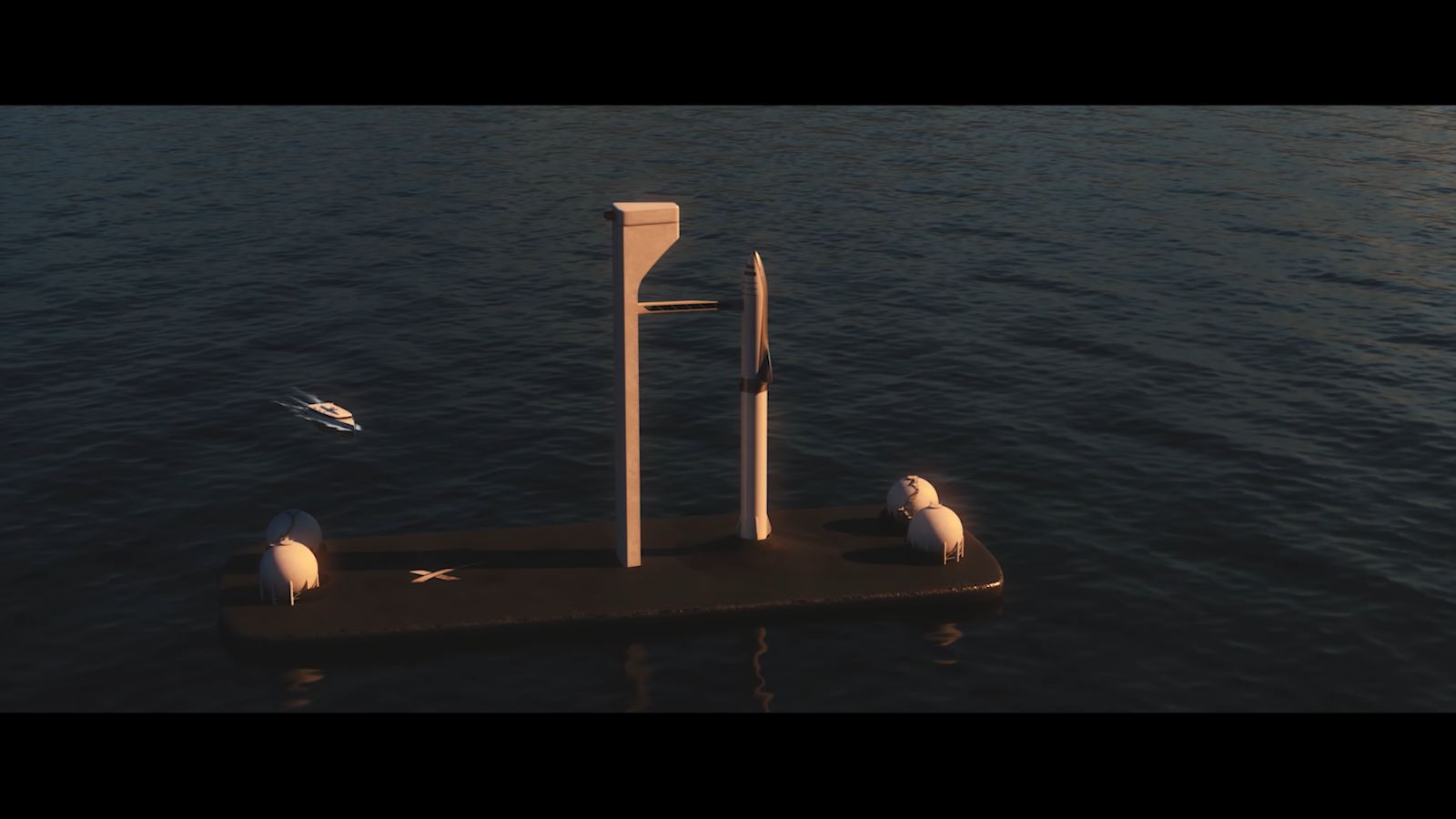The launch of a rocket into orbit should never become routine. There was a time, probably around the 50’s and 60’s that a rocket launch hit the headlines. Now its just another launch. Last year (2024) saw a record breaking 263 launches. The US launched 158, China launched 68 and other countries/regions like Europe, Russian and Japan. Last year just 224 launches were completed and two years ago in 2022, 168 launches were completed. Surprisingly perhaps, prior to 2020 the record was set at 141 back in 1967, the future of rocket flight still seems quite alive!
Starships Will be Launching From These Oil Drilling Platforms Bought by SpaceX
Over the years, Elon Musk has been rather open about how he (and the company he founded) plan to make space more accessible and allow humanity to become an “interplanetary species.” A key element to this plan is the Starship and Super-Heavy launch system, which will allow for regular trips to the Moon as well as the eventual creation of the first human colony on Mars.
Another key part of Musk’s plan is the creation of spaceports at sea that will allow for greater flexibility with launches and landings. To that end, SpaceX recently acquired two former oil drilling rigs off the coast of Texas. These spaceports have been dubbed Phobos and Deimos (after Mars’ two satellites) and are currently undergoing modifications to conduct Starship launches in the near future.
Continue reading “Starships Will be Launching From These Oil Drilling Platforms Bought by SpaceX”SpaceX Falcon 9 Set for Post-Midnight Blastoff and Landing on Aug. 14 – Watch Live


KENNEDY SPACE CENTER, FL – Scarcely three weeks after the mesmerizing midnight launch and landing of a SpaceX Falcon 9 rocket that delivered over two tons of science and critical hardware to the space station for NASA, the innovative firm is set to repeat the back to back space feats – with a few big twists – during a post midnight launch this Sunday, Aug.14 of a Japanese telecom satellite.
In less than 24 hours, a freshly built SpaceX Falcon 9 is set to transform night into day and launch the JCSAT-16 communications satellite from Space Launch Complex 40 on Cape Canaveral Air Force Station in Florida.
And some nine minutes later, the 15 story Falcon 9 first stage is scheduled to make a pinpoint soft landing on a tiny, prepositioned drone ship at sea in the vast Atlantic Ocean.
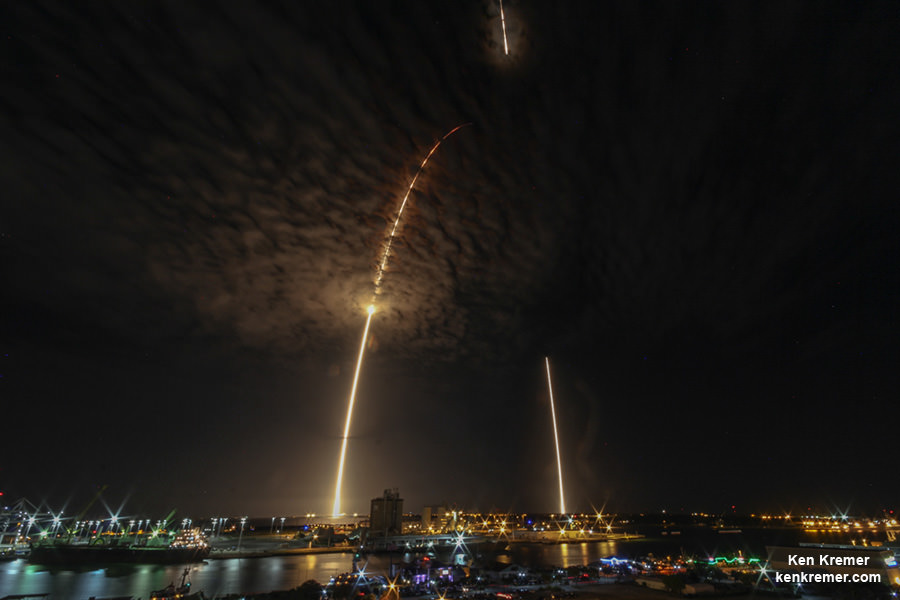
To date SpaceX has successfully soft landed 5 first stage boosters over the past eight months – two by land and three by sea.
Nighttime liftoffs are always a viewing favorite among the general public – whether visiting from near or far. And this one is virtually certain to offer some spectacular summer fireworks since the weather looks rather promising – if all goes well.
Sunday’s launch window opens at 1:26 a.m. EDT and extends two hours long for the 229 foot tall Falcon 9 rocket. The window closes at 3:26 a.m. EDT.
The commercial mission involves lofting the JCSAT-16 Japanese communications satellite to a Geostationary Transfer Orbit (GTO) for SKY Perfect JSAT – a leading satellite operator in the Asia – Pacific region. JCSAT-16 will be positioned 22,300 miles (35,800 kilometers) above the equator.
Sunday’s launch is the second this year for SKY Perfect JSAT. The JCSAT-14 satellite was already launched earlier this year on May 6.
You can watch the launch live via a special live webcast from SpaceX.
The SpaceX webcast will be available starting at about 20 minutes before liftoff, at approximately 1:06 a.m. EDT at SpaceX.com/webcast
The weather currently looks very good. Air Force meteorologists are predicting an 80 percent chance of favorable weather conditions at launch time in the wee hours early Sunday morning.
The primate concerns are for violations of the Cumulus Cloud and Think Cloud rules.
The U.S. Air Force’s 45th Space Wing will support SpaceX’s Falcon 9 launch of JCSAT-16.
In cases of any delays for technical or weather issues, a backup launch opportunity exists 24 hours later on Monday morning with a 70 percent chance of favorable weather.
The rocket has already been rolled out to the launch pad on the transporter and raised to its vertical position.
The path to launch was cleared following the successful Aug. 10 hold down static fire test of the Falcon 9 first stage Merlin 1-D engines. SpaceX routinely performs the hot fire test to ensure the rocket is ready.
Watch this crystal clear video of the Static Fire Test from USLaunchReport:
Video Caption: SpaceX – JCSAT-16 – Static Fire Test 08-10-2016. On a humid, windless evening at 11 PM, JCSAT-16 gave one good vapor show. Credit: USLaunchReport
Via a fleet of 15 satellites, Tokyo, Japan based SKY Perfect JSAT provides high quality satellite communications to its customers.
The JCSAT-16 communications satellite was designed and manufactured by Space Systems/Loral for SKY Perfect JSAT Corporation.
JCSAT-16 satellite will separate from the second stage and will be deployed about 32 minutes after liftoff from Cape Canaveral. The staging events are usually broadcast live by SpaceX via stunning imagery from onboard video cameras.
A secondary objective is to try and recover the first stage booster via a propulsive landing on an ocean-going platform.
This booster is again equipped with 4 landing legs and 4 grid fins.
Following stage separation, SpaceX will try to soft land the first stage on the “Of Course I Still Love You” drone ship positioned about 400 miles (650 km) off shore of Florida’s east coast in the Atlantic Ocean.
But SpaceX officials say landings from GTO mission destinations are extremely challenging because the first stage will be subject to extreme velocities and re-entry heating.
If all goes well with the supersonic retropropulsion landing on the barge, the booster will arrive back into Port Canaveral a few days later.
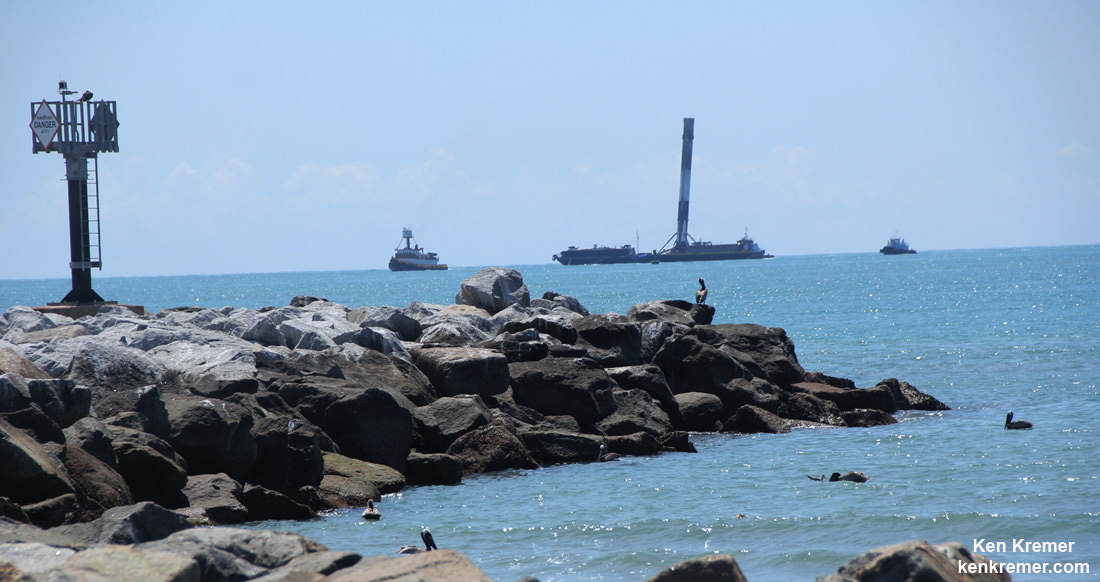
To date SpaceX has successfully recovered first stages three times in a row at sea this year on the an ocean going drone ship barge using the company’s OCISLY Autonomous Spaceport Drone Ship (ASDS) on April 8, May 6 and May 27.
Stay tuned here for Ken’s continuing Earth and planetary science and human spaceflight news.
Ken Kremer
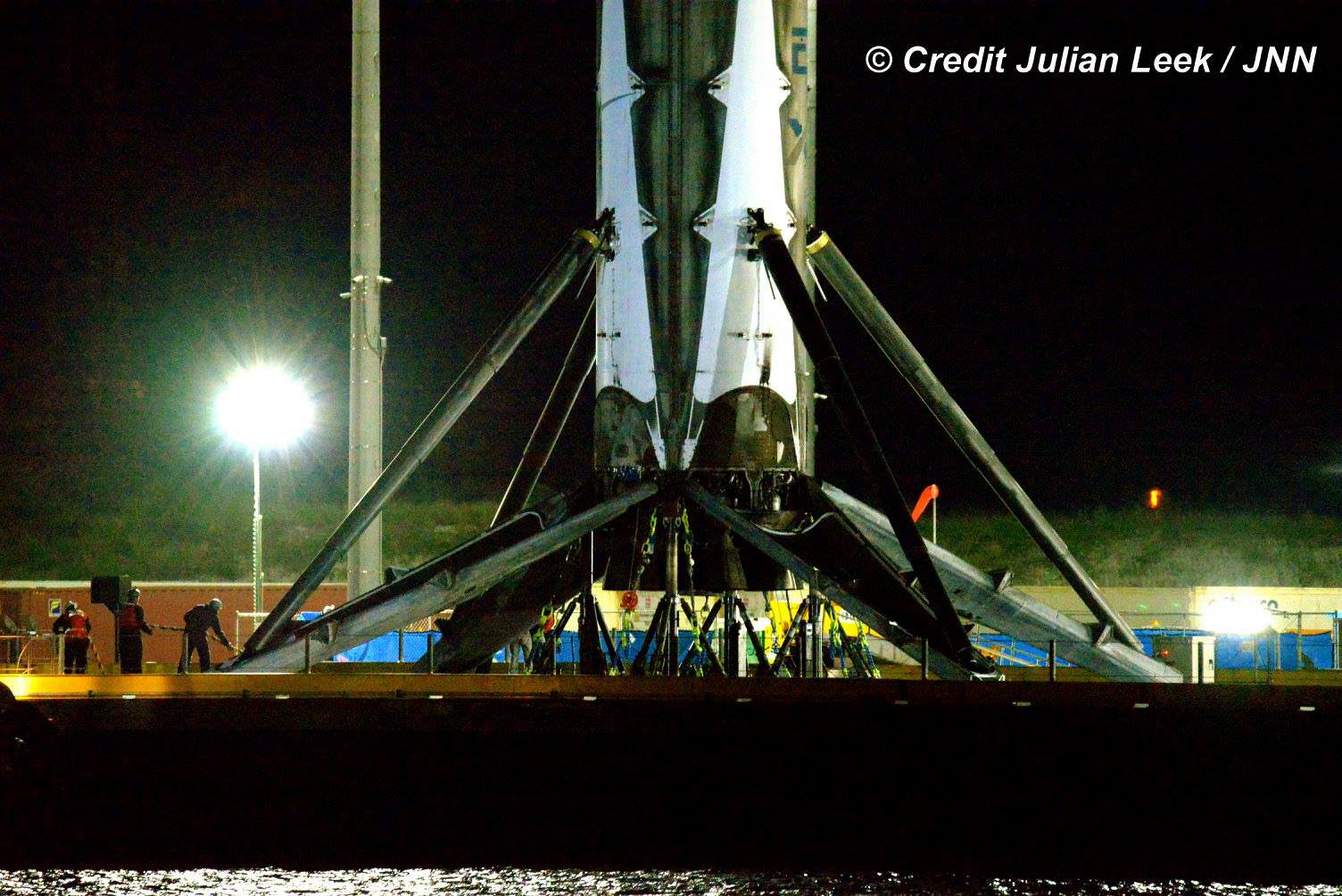
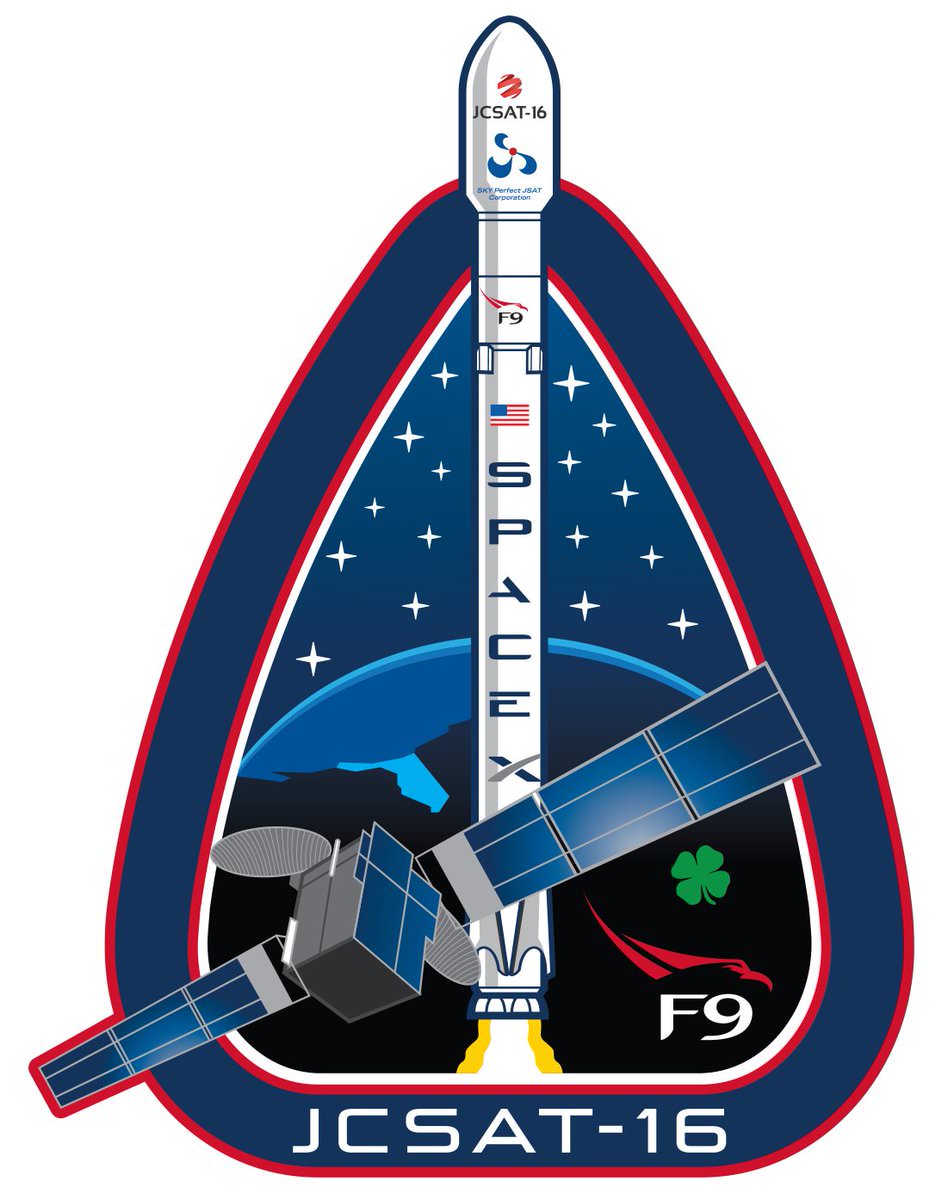
………….
Learn more about SpaceX missions, Juno at Jupiter, SpaceX CRS-9 rocket launch, ISS, ULA Atlas and Delta rockets, Orbital ATK Cygnus, Boeing, Space Taxis, Mars rovers, Orion, SLS, Antares, NASA missions and more at Ken’s upcoming outreach events:
Aug 12-14: “SpaceX missions/launches to ISS on CRS-9, Juno at Jupiter, ULA Delta 4 Heavy spy satellite, SLS, Orion, Commercial crew, Curiosity explores Mars, Pluto and more,” Kennedy Space Center Quality Inn, Titusville, FL, evenings
SpaceX Targets Thursday May 26 for Thai Comsat Launch and Tough Sea Landing – Watch Live
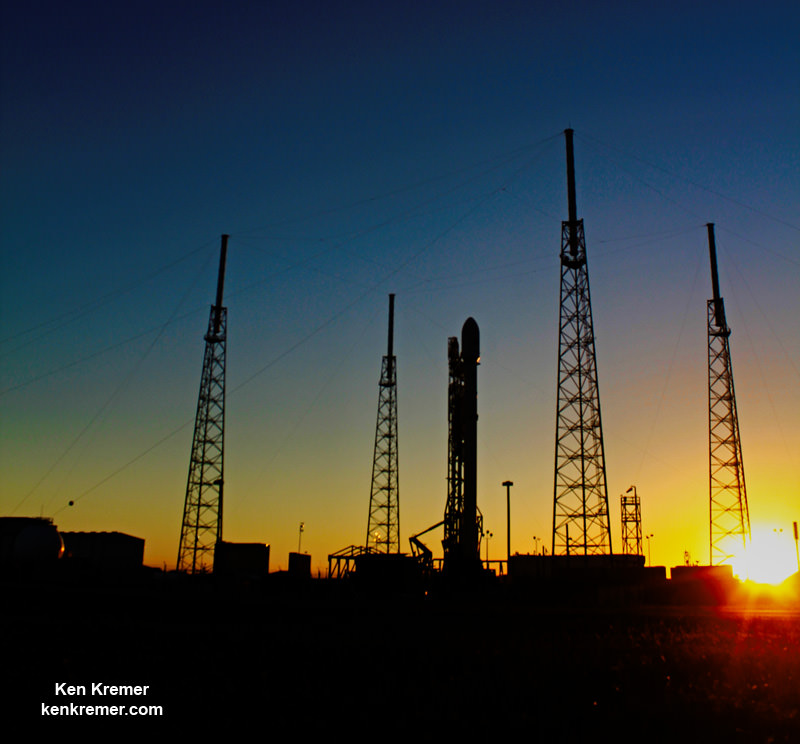

CAPE CANAVERAL AIR FORCE STATION, Fla. – Just three weeks after SpaceX’s last launch from their Florida launch base, the growing and influential aerospace firm is deep into commencing their next space spectacular – targeting this Thursday, May 26, for launch of a Thai comsat followed moments later by a sea landing attempt of the booster on a tough trajectory.
SpaceX is slated to launch the Thaicom-8 telecommunications satellite atop an upgraded version of the SpaceX Falcon 9 on Thursday at 5:40 p.m. EDT from Space Launch Complex-40 at Cape Canaveral Air Force Station in Florida.
SpaceX is rapidly picking up the pace of rocket launches for their wide ranging base of commercial, government and military customers that is continuously expanding and reaping contracts and profits for the Hawthorne, Calif. based company.
This commercial mission involves lofting Thaicom-8 to a Geostationary Transfer Orbit (GTO) for Thaicom PLC, a leading satellite operator in Asia.
This also counts as the second straight GTO launch and the second straight attempt to land a rocket on a sea based platform from the highly demanding GTO launch trajectory.
Will this mission make for 3 successful Falcon 9 1st stage booster landings in a row? Tune in and find out !!
Engineers have a two-hour window to launch the Falcon 9 and deliver Thaicom to orbit.
Thaicom-8 was built by aerospace competitor Orbital ATK, based in Dulles, VA. It will support Thailand’s growing broadcast industry and will provide broadcast and data services to customers in South Asia, Southeast Asia and Africa.
The Falcon 9 launch is the 5th this year for SpaceX.
You can watch the launch live via a special live webcast from SpaceX.
The SpaceX webcast will be available starting at about 20 minutes before liftoff, at approximately 5:20 a.m. EDT at SpaceX.com/webcast
The two stage Falcon 9 rocket has a two-hour launch window that extends until Thursday, May 26 at 7:40 p.m. EDT.
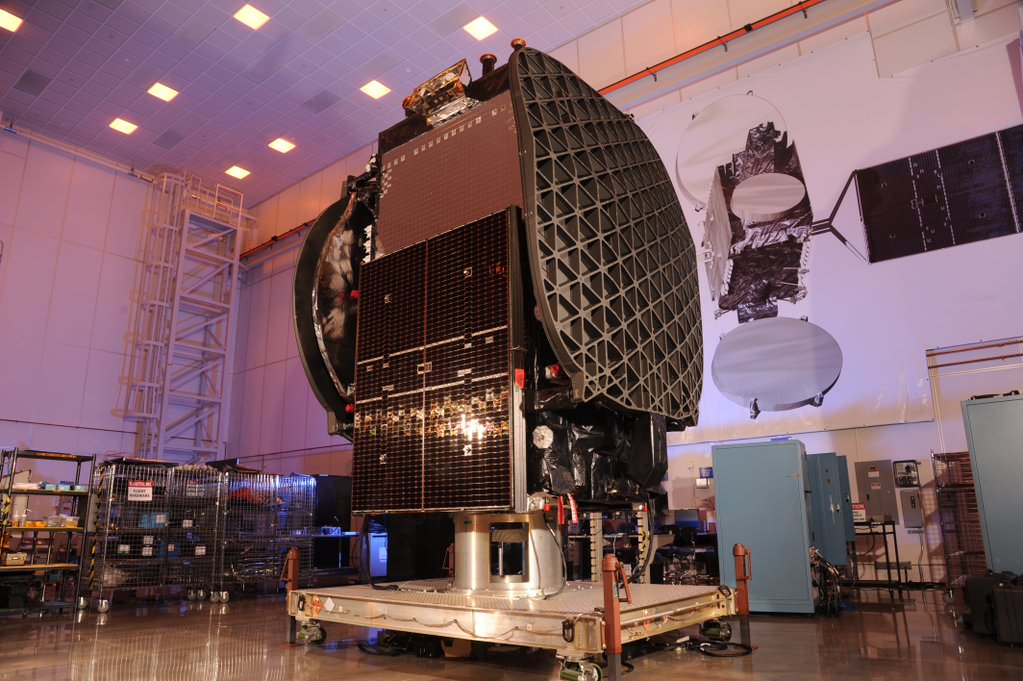
The path to liftoff was cleared late last night the company completed the customary pre-launch static fire test of the rocket’s first stage upgraded Merlin 1D engines for several seconds at pad 40.
The nine engines on the 229 foot tall Falcon 9 rocket generate approximately 1.5 million pounds of thrust.
Engineers monitored the test and after analyzing results declared the Falcon 9 was fit to launch Thursday afternoon.
The weather currently looks very good. Air Force meteorologists are predicting a 90 percent chance of favorable weather conditions at launch time Thursday morning with a minor concern for ground winds.
The backup launch opportunity is Friday, May 27. The weather outlooks is somewhat less promising at a 70 percent chance of favorable conditions.
After the Falcon 9 rocket delivers the satellite into its targeted geosynchronous transfer orbit it will enter a 30-day testing phase, says Orbital ATK.
Following in-orbit activation and after reaching its final orbital slot, Orbital ATK will then turn over control of the satellite to Thaicom to begin normal operations.
THAICOM 8’s orbital location will be positioned at 78.5 degrees east longitude and the satellite is designed to operate for more than 15 years.
Thaicom-8 is a Ku-band satellite that offers 24 active transponders that will deliver broadcast and data services to customers in Thailand, Southeast Asia, India and Africa.
Thaicom-8 has a mass of approximately 6,800 pounds (3,100 kilograms). It is based on Orbital ATK’s flight-proven GEOStar-2TM platform.
“We built and delivered this high-quality communications satellite for Thaicom PLC two months ahead of schedule, demonstrating our ability to manufacture reliable, affordable and innovative products that exceed expectations for our customer,” said Amer Khouri, Vice President of the Commercial Satellite Business at Orbital ATK.
“As one of Asia’s leading satellite operators, we are grateful for Thaicom’s continued confidence and look forward to more successful partnerships in the future.”
Thaicom-8 will join Thaicom-6 already in orbit. It was also designed, manufactured, integrated and tested by Orbital ATK. at the firm’s state-of-the-art satellite manufacturing facility in Dulles, Virginia.
Thaicom PLC commissioned Thaicom-8 in 2014, shortly after SpaceX launched the THAICOM 6 satellite into orbit in January 2014.
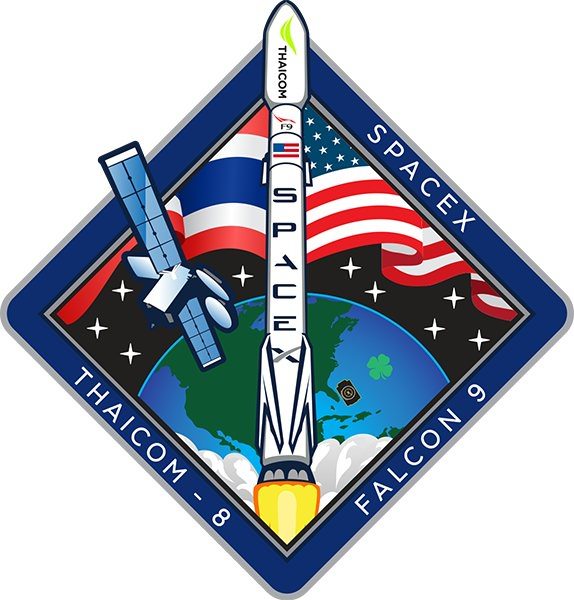
The secondary test objective of SpaceX is to land the Falcon 9 rockets first stage on an ocean going barge several hundred miles offshore in the Atlantic Ocean.
The Autonomous Spaceport Drone Ship (ASDS) barge is named “Of Course I Still Love You.”
However with this mission’s GTO destination, the first stage will be subject to extreme velocities and re-entry heating and a successful landing will be difficult.
Having said that and despite those hurdles, the last GTO mission landing attempt did succeed brilliantly following the May 6 JCSAT-14 launch.
Tune in to the SpaceX webcast Thursday afternoon to catch all the exciting action !!
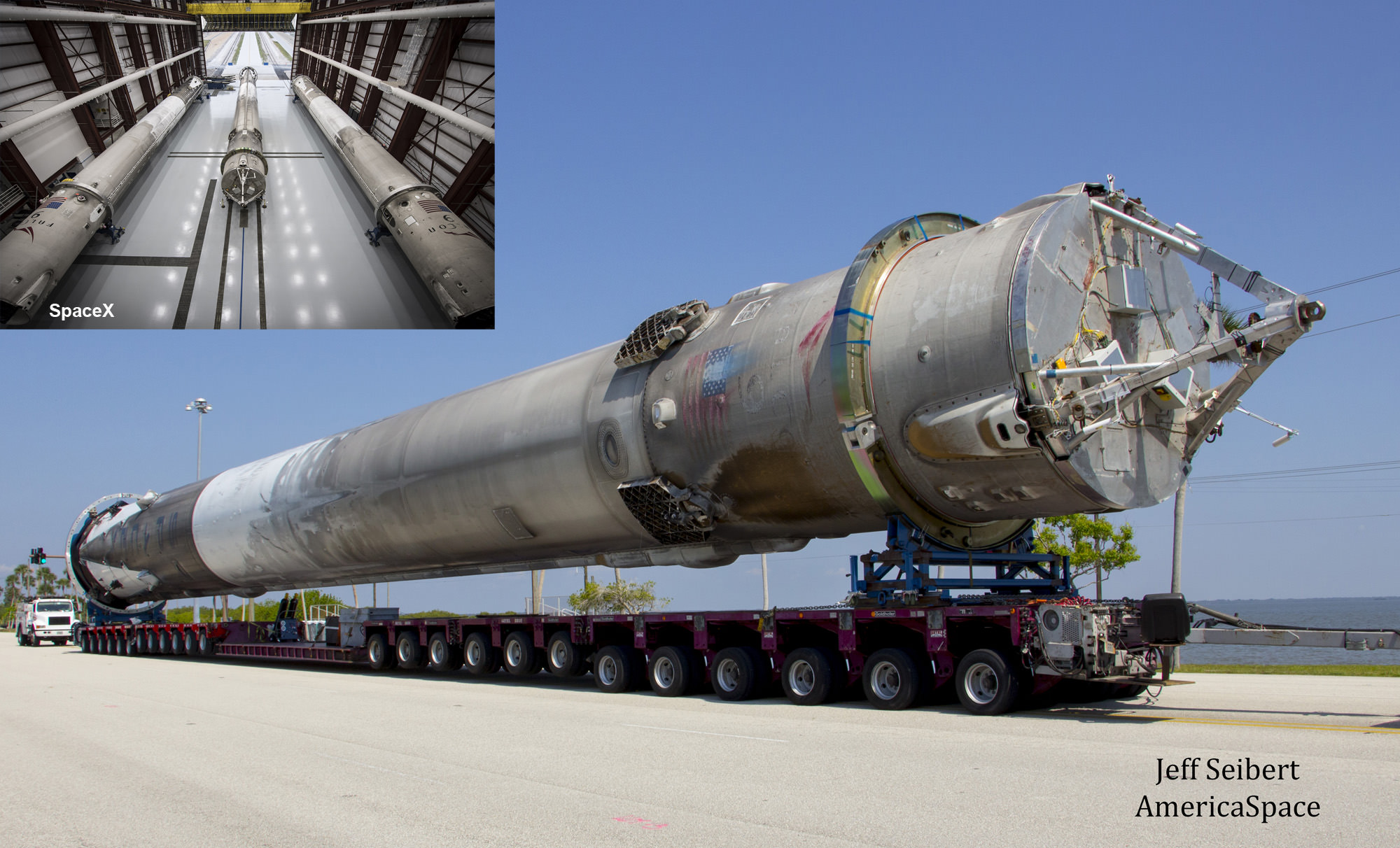
Watch for Ken’s on site reports direct from Cape Canaveral and the SpaceX launch pad.
Stay tuned here for Ken’s continuing Earth and planetary science and human spaceflight news.
………….
Learn more about SpaceX Falcon 9 rocket, ULA Atlas rocket, Orbital ATK Cygnus, ISS, Boeing, Space Taxis, Mars rovers, Orion, SLS, Antares, NASA missions and more at Ken’s upcoming outreach events:
May 25/26: “SpaceX, ULA, SLS, Orion, Commercial crew, Curiosity explores Mars, Pluto and more,” Kennedy Space Center Quality Inn, Titusville, FL, evenings
Jun 2 to 5: “ULA, NRO, SpaceX, SLS, Orion, Commercial crew, Curiosity explores Mars, Pluto and more,” Kennedy Space Center Quality Inn, Titusville, FL, evenings
Amazing Time-lapse Shows Recovered SpaceX Falcon 9 Moving To Land After Port Canaveral Arrival
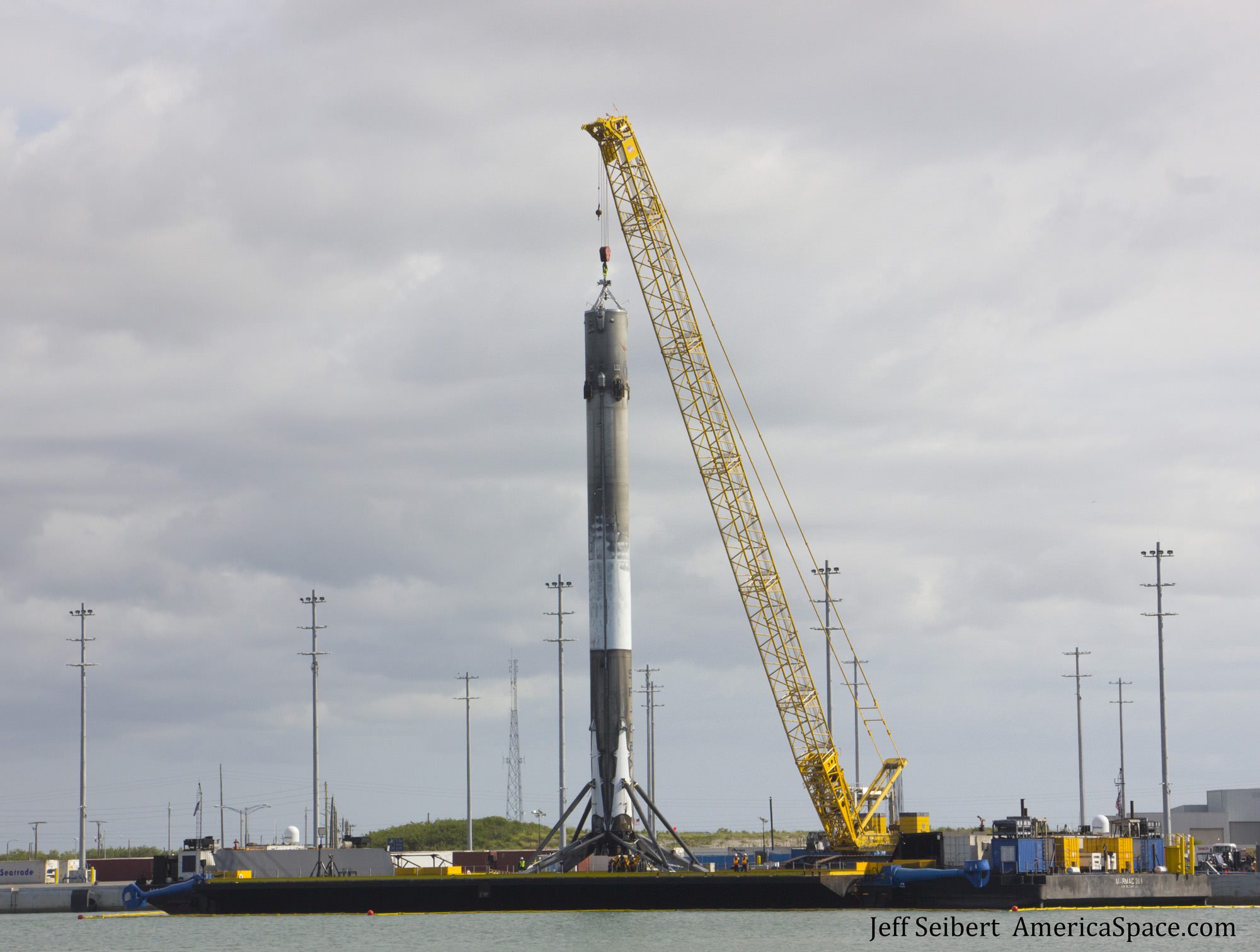

The recovered SpaceX first stage booster that nailed a spectacular middle-of-the-night touchdown at sea last week sailed back to Port Canaveral, Florida, late Monday and was transferred by crane on Tuesday from the drone ship to land – as seen in an amazing time-lapse video and photos, shown above and below and obtained by Universe Today.
The exquisite up close time-lapse sequence shows technicians carefully hoisting the 15-story-tall spent booster from the drone ship barge onto a work pedestal on land some 12 hours after arriving back in port.
The time-lapse imagery (below) of the booster’s removal from the drone ship was captured by my space photographer friend Jeff Seibert on Tuesday, May 10.
Video Caption: 20X time-lapse of the first stage booster from the SpaceX JCSAT-14 launch being transferred on May 10, 2016 from the autonomous drone ship “Of Course I Still Love You” (OCISLY) to a work pedestal on land 12 hours after arriving at the dock. Credit: Jeff Seibert
Towards the end of the video there is a rather humorous view of the technicians climbing in unison to the bottom of the hoisted Falcon.
“I particularly like the choreographed ascent by the crew to the base of the Falcon 9 near the end of the move video,” Seibert told Universe Today.
The move took place from 11:55 AM until 12:05 PM, Seibert said.
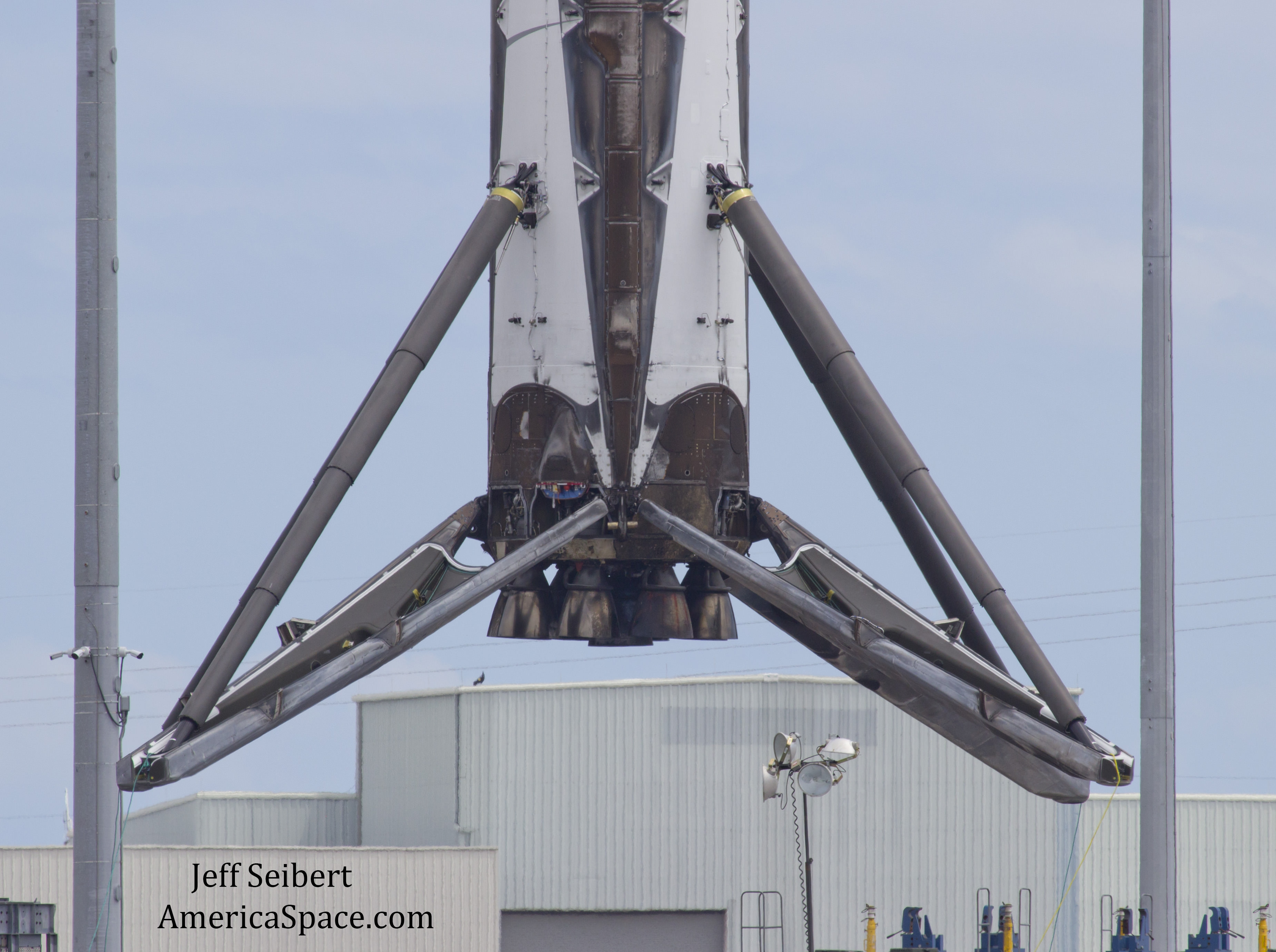
The booster was towed into the space coast port around 11 p.m. Monday night, as seen in further up close images captured by my space photographer friend Julian Leek.
Leek also managed to capture a stunningly unique view of the rocket floating atop the barge when it was still out at sea and some 5 miles off shore waiting to enter the port at a safe time after most of the cruise ships had departed – as I reported earlier here.
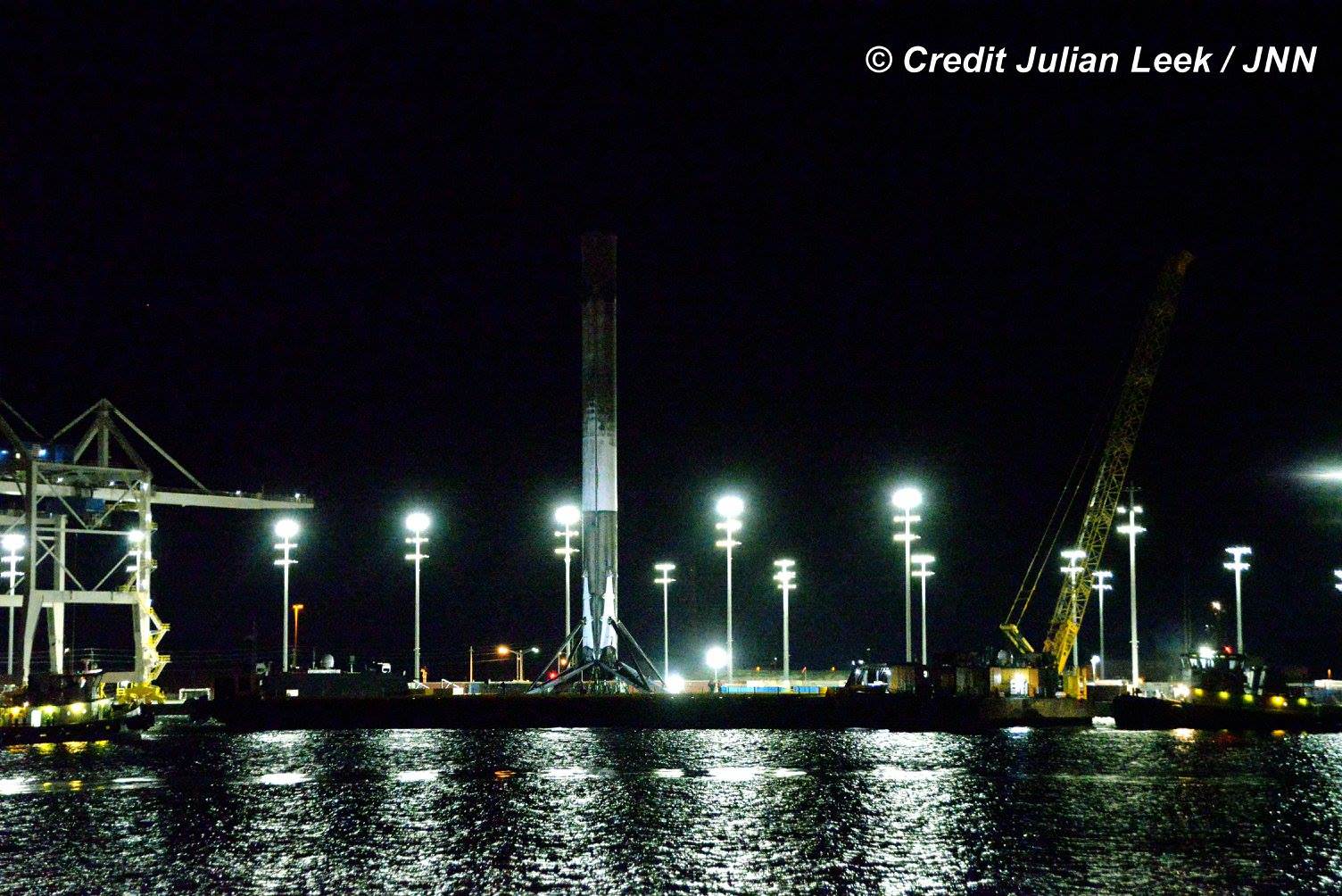
The 156 foot tall booster safely soft landed on the drone ship named “Of Course I Still Love You” or “OCISLY” barely nine minutes after liftoff of the SpaceX Falcon 9 last week on a mission to deliver the Japanese JCSAT-14 telecom satellite to a Geostationary Transfer Orbit (GTO).
The upgraded SpaceX Falcon 9 soared to orbit on May 6, roaring to life with 1.5 million pounds of thrust on a mission carrying the JCSAT-14 commercial communications satellite, following an on time liftoff at 1:21 a.m. EDT from Space Launch Complex 40 at Cape Canaveral Air Force Station, Fl.
The first stage then carried out a propulsive soft landing on the ocean going platform located some 400 miles off the east coast of Florida.
To date SpaceX has recovered 3 Falcon 9 first stages. But this was the first one to be recovered from the much more demanding, high velocity trajectory delivering a satellite to GTO.
The first rocket was flying faster and at a higher altitude at the time of seperatoin from the second stage and thus was much more difficult to slow down and maneuver back to the ocean based platform.
Thus SpaceX officials and CEO Elon Musk had been openly doubtful of a successful outcome for this landing attempt.
“First landed booster from a GTO-class mission (final spacecraft altitude will be about 36,000 km),” tweeted SpaceX CEO and founder Elon Musk.
The commercial SpaceX launch lofted the JCSAT-14 Japanese communications satellite to a Geostationary Transfer Orbit (GTO) for SKY Perfect JSAT – a leading satellite operator in the Asia – Pacific region.

The landing counts as another stunning success for Elon Musk’s vision of radically slashing the cost of sending rocket to space by recovering the boosters and eventually reusing them.
The next step is to defuel the booster and remove the landing legs. Thereafter it will be tilted and lowered horizontally and then be placed onto a multi-wheeled transport for shipment back to SpaceX launch facilities at Cape Canaveral for refurbishment, exhaustive engine and structural testing.
The newly recovered first stage will join a fleet of two others recovered last December and in April.
“May need to increase size of rocket storage hangar,” tweeted Musk.
If all goes well the recovered booster will eventually be reflown.
The next SpaceX commercial launch is tentatively slated for the late May/early June timeframe.
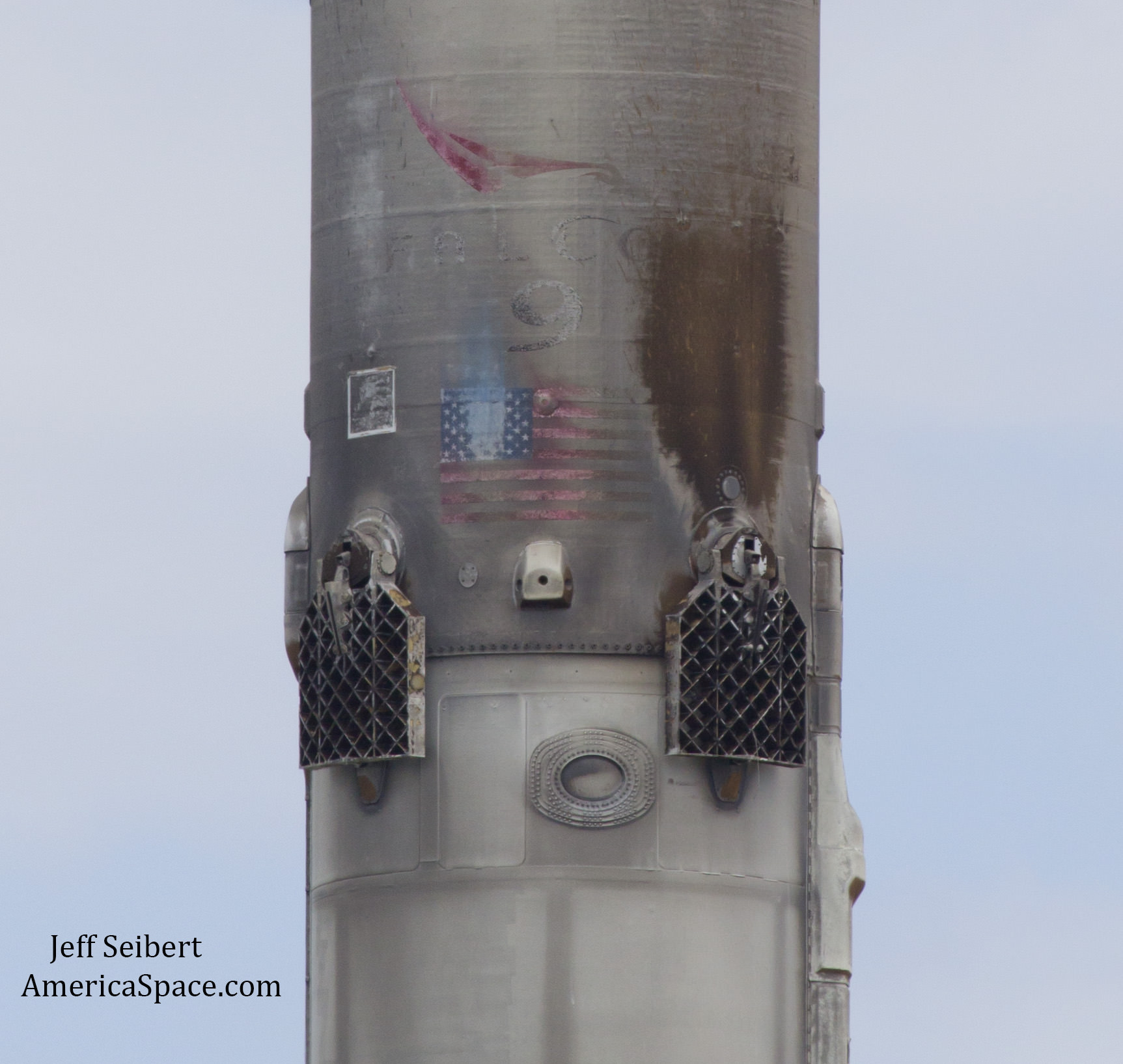
Stay tuned here for Ken’s continuing Earth and planetary science and human spaceflight news.
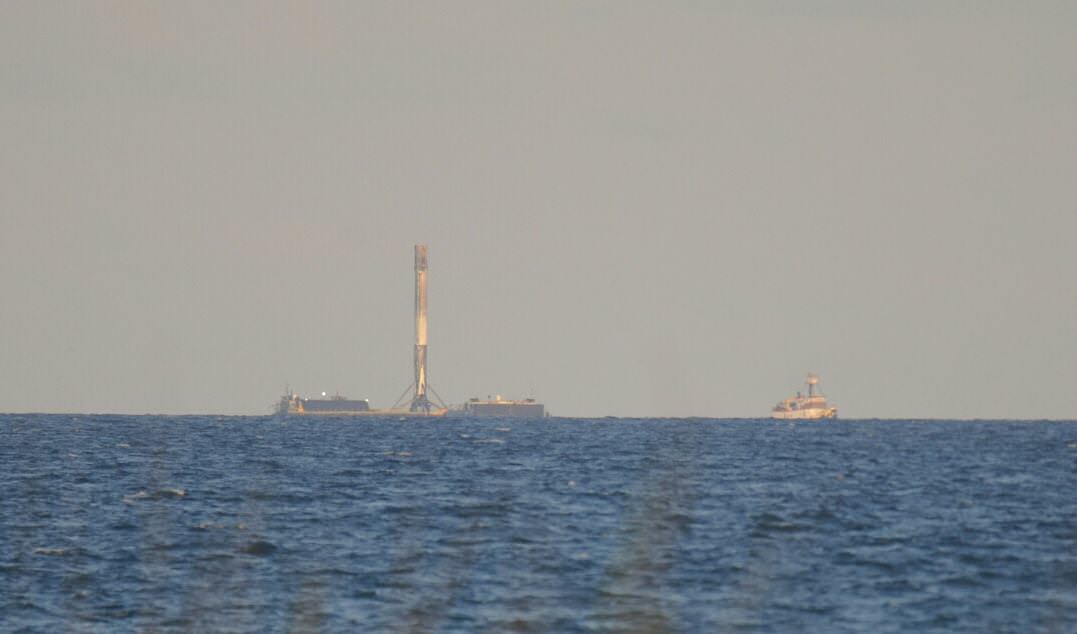
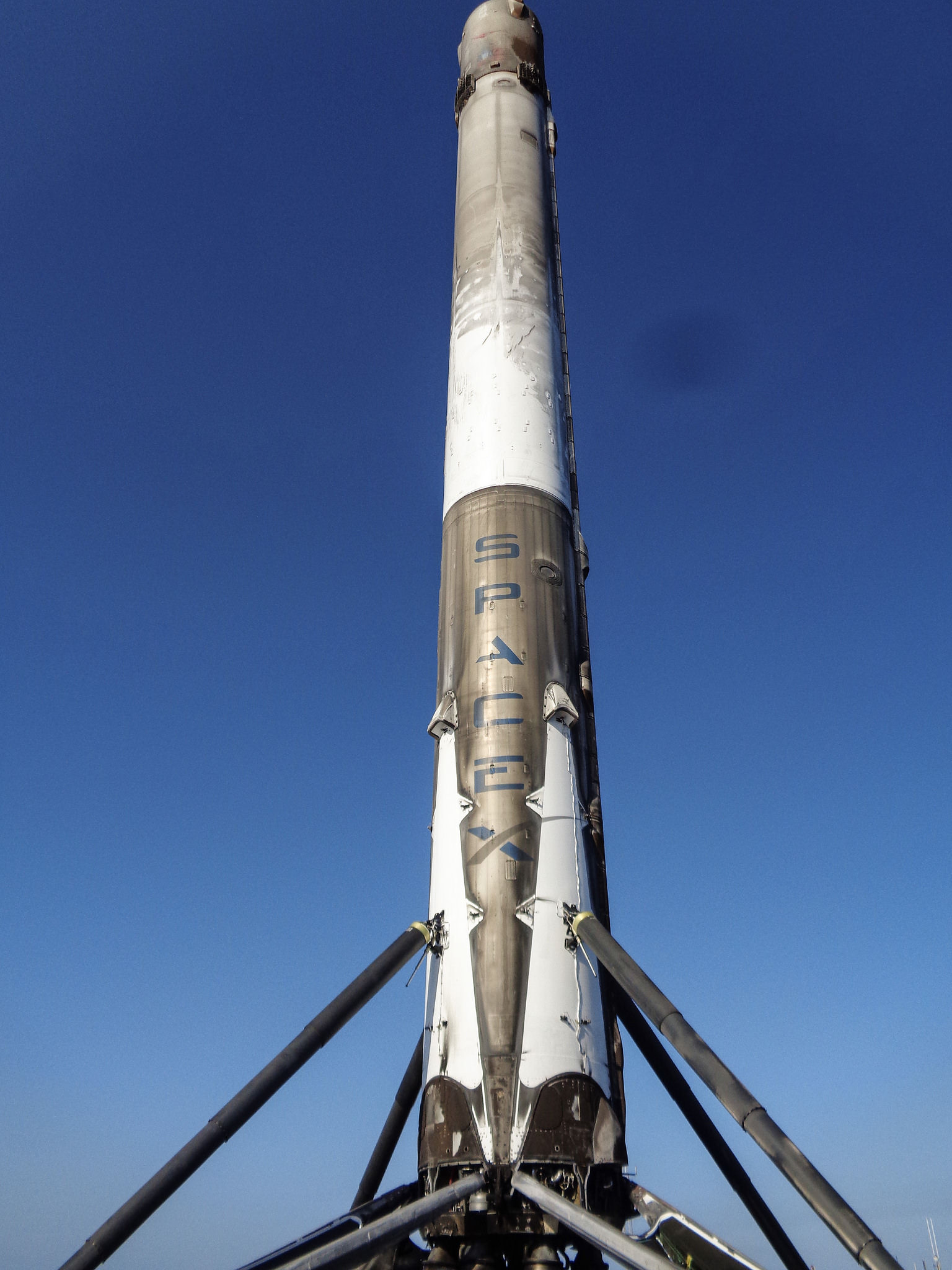
Video caption: SpaceX Falcon 9 launch of JCSAT-14 on May 6, 2016 from Space Launch Complex 40 at Cape Canaveral Air Force Station, Fl. Credit: Ken Kremer/kenkremer.com


